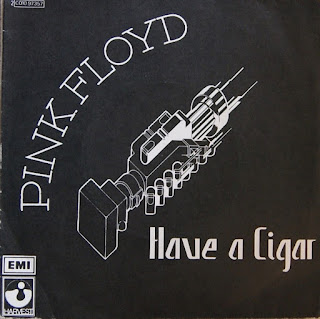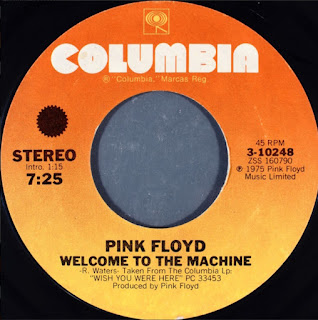PINK FLOYD - HAVE A CIGAR / WELCOME TO THE MACHINE
HAVE A CIGAR
Released: November 1975
"Have a Cigar" is the third track on Pink Floyd's 1975 album “Wish You Were Here”. The song serves as Roger Waters' satirical critique of the music industry and its exploitation of artists. The lyrics sarcastically depict the insincere and indifferent attitude of record executives, emphasizing their profit-driven motives and lack of genuine interest in the musicians themselves. The repeated line "We call it riding the gravy train" underscores the cynical view of the industry as a money-making endeavor, with little concern for the artists' well-being. The decision to have Roy Harper, a folk-rock singer, provide lead vocals adds a layer of irony, as it emphasizes the disconnection between the executives and the artists they supposedly represent.
Roy Harper's involvement in providing lead vocals for "Have a Cigar" stemmed from Roger Waters' vocal strain during the recording of "Shine On You Crazy Diamond." As David Gilmour was not comfortable singing the song, they turned to their friend Harper, who was conveniently recording nearby. Gilmour's recollection highlights the initial resistance to Harper's suggestion, but ultimately, his rendition brought a distinct quality to the track. It's interesting to note the dynamic and reactions within the band regarding Roy Harper's contribution to the song.
"Have a Cigar" serves as a satirical take on record company executives and their clichéd interactions with new bands. Fueled by Pink Floyd's frustration with the music industry, Roger Waters crafted lyrics that encapsulated the insincerities and empty promises often encountered. The iconic line "By the way, which one's Pink?" reflects the band's exasperation with the industry's lack of understanding of their identity. This track, added late in the album's production, became a fitting commentary on the band's relationship with the record company, portrayed on the back cover with an image of a soulless salesman offering Pink Floyd albums in a desert.
"Have a Cigar" stands out on the album for its more straightforward and rock-oriented approach. Unlike the other tracks that either fade in or seamlessly transition, this song starts abruptly with a churning riff on electric guitar and bass. The rock texture is further enriched by additional guitar, electric piano, and synthesizer parts. The track features a guitar solo and concludes with a distinctive moment where the music is interrupted by a synthesizer filter-sweep sound effect, followed by a reduction in volume to an AM radio-like quality. The song concludes with the sound of a radio being tuned off-station, serving as a transition to the title track, "Wish You Were Here."
WELCOME TO THE MACHINE
Released: September 13, 1975
"Welcome to the Machine" serves as the second track on Pink Floyd's 1975 album "Wish You Were Here." Written by bassist Roger Waters, the song delves into the theme of the music industry's control over artists, particularly reflecting on the impact on Pink Floyd founder Syd Barrett's mental health. The lyrics and music highlight the pervasive influence of record producers and managers, portraying the world as a machine dictating what the band and individuals like Syd Barrett should do to achieve success. The album as a whole explores the factors contributing to Syd Barrett's breakdown and his absence from the band.
The animated music video for "Welcome to the Machine," created by Gerald Scarfe, served as a backdrop film during Pink Floyd's 1977 In the Flesh tour. The imaginative video features a giant mechanical Horned Toad, transitioning into a desolate industrial cityscape with eerie and surreal elements. The scenes include a cracked cylinder oozing blood, an unfolding cuboid, girders with decayed corpses and rats, and a tower morphing into a screaming form. A notable sequence involves a head decomposing into a skull, and the video concludes with a monolith surviving a sea of blood, ascending into space, and fitting into a massive floating object. The visuals complement the synthesized sound of the track, providing a vivid and symbolic representation of the song's themes.

















Cap comentari:
Publica un comentari a l'entrada